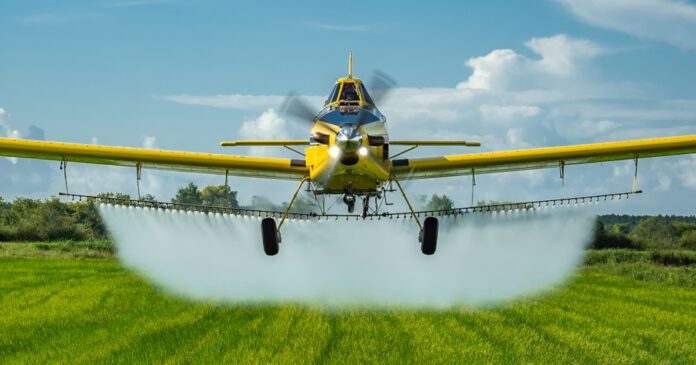The National Agricultural Aviation Association (NAAA) has appealed to operators of unmanned aircraft (UAs) to “be mindful” of the vulnerability of low-flying aircraft flying aerial applications missions. “With Russia’s invasion of Ukraine restricting a huge portion of the world’s food supply,” said NAAA CEO Andrew Moore, “we cannot afford even a small disruption in the nation’s food supply chain. Agricultural aviators deliver nutrients, seeds and crop protection products to crops that will become consumers’ food and fiber supply in the U.S. and around the world. Their work cannot be delayed because of an unmanned aircraft not yielding to them, as is required by law.”
Agricultural aviators, who treat 127 million acres of cropland in the United States each year, fly as low as 10 feet off the ground, sharing airspace with UAs that are restricted by law to altitudes less than 400 feet above the surface. The association cited a test conducted by stakeholders including the Colorado Agricultural Aviation Association and other manned and unmanned aircraft organizations. The test showed that pilots were unable to continuously visually track a 28-inch-wide unmanned aircraft when flying at regular speeds. “While they might be spotted for a second,” NAAA wrote, “UAs are not constantly visible to pilots, meaning it is up to the drone operator to avoid a collision.”
NAAA recommends that unmanned aircraft operators:
Give the right of way to a manned aircraft; Equip drones with tracking technology, such as ADS-B In; Get certified and well-trained in operating an unmanned aircraft; Contact local consult AgAviation.org/findapplicator before flying their drones; Equip UAs with visible strobe lights and high visibility marking; Carry UA liability insurance; and “Land your unmanned aircraft immediately when a low-flying aircraft is nearby.”




































RemoteID could help AG pilots determine before a flight if there’s a drone operating nearby but there will still be drones flying without it. I used to fly forest fires in a Cessna A185F spotter plan and I encountered drones illegally at the scene of a fire a couple of times. They are impossible to see from an airplane traveling at 80 – 90 kts while banking and circling. Drone operators could make it safer for manned aircraft by using a LAANC compatible service to identify their operations area beforehand. Many of them do now as demonstrated by the number of DNOTAMs but not most. A drone operator stands to lose about $1,500 but the manned aircraft pilot stands to lose his/her life.
Why isn’t HAI a signatory on this as well?
As both a private pilot, licensed UAS pilot, and a r/c hobby pilot, I can look at both sides of this. Agreed – they’d be almost impossible to see. Even ‘full scale’ airplanes can be tough to spot, much of the time. A collision with a drone could be catastrophic, or fatal. I sincerely hope there’s no one sick enough to do that on purpose. IF the perpetrator was caught, I’d guess the penalties could be much stiffer than $1500 – most likely, be ‘made an example of’.
ADS-B for ‘drones’ would make actually sense: but that’s NOT what the FAA (and others) wrote into the latest rules. Instead, it’s some yet-to-be fully defined, internet-linked, ‘remote ID’ which will be totally distinct from ADS-B, and was created not for direct aircraft safety, but created as a law enforcement tool. (i.e. catch the guy who’s buzzing the football stadium)
If you want to see the drone signals (when that finally gets defined), you’ll need another piece of electronics (yet to be created) in your aircraft; and that’s assuming that the owner had added ‘remote ID’ to his drone (because NONE of them have it currently).
FWIW, ‘drones’ are not necessarily restricted to 400 feet – now it’s, generally, any class G airspace. And, LAANC only applies to controlled airspace (e.g. in the vicinity of a controlled airport.) It doesn’t apply to someone flying over some farm field out in the country.
Maybe the best solution would be to put drone-proof windshields in ag planes – that’d keep the stray goose or crow from coming through, as well.
I’ve been building and flying radio-controlled model airplanes since 1963. In the mid-1970’s, I obtained a private pilot’s license via the GI Bill and flew a Cherokee Arrow II for a few years until I could no longer afford it. I don’t know why, but I’ve loved aviation since I was a toddler. If I hear an airplane flying nearby, I’m going to try to put my eyes on it before it gets out of sight. Most of my model airplanes are miniature versions of full-scale fixed-wing planes. In the 59 years that I’ve flown radio-controlled models, none of my planes have been anywhere near a full-scale aircraft. I’ve been a member of the Academy of Model Aeronautics (AMA) and the local AMA flying club most of my adult life. All of our club members fly fixed-wing airplanes, a few fly model helicopters, and only one or two fly quadcopters. We don’t use the word “drone”. Anyone can “fly” a drone since it can basically fly itself. Our model airplanes and helicopters require skill to fly and must remain within our line-of-sight for us to control them. We’re airplane people. I can assure you that if you’re dusting a field near us, we’re going to park our planes and watch you make those low passes and tight turns.